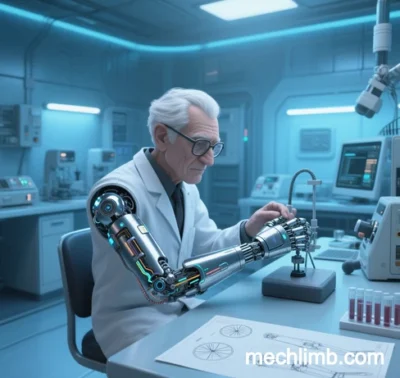
Mech Limb: Advances and Prospects in Medical Rehabilitation and Functional Restoration
Mech Limbs—bionic prosthetics integrating robotics, neuroscience, and materials science—aim to restore or enhance human mobility through precision sensors, intelligent control systems, and biocompatible materials. These devices prioritize natural interaction, dynamic adaptability, and lifelong rehabilitation, addressing limitations of traditional prosthetics like limited functionality and poor fit. Below is an analysis of their breakthroughs and future potential.
I. Technological Breakthroughs and Case Studies
1. Neural-Mechanical Interface Innovations
- Bidirectional Neural Pathways: ROBO Medical’s smart upper-limb prosthetic uses flexible sensors and neural decoding algorithms to achieve closed-loop control (intent recognition, motion execution, tactile feedback). Users control the limb via residual muscle microcurrents while receiving real-time grip force and temperature feedback.
- Spinal Signal Integration: International teams developed sensors that capture spinal motor neuron signals, enabling prosthetics to perform complex tasks (e.g., elbow flexion, wrist rotation) with over 60% higher precision than traditional myoelectric models. Volunteers achieved a 92% success rate in grasping tasks.
2. Bionic Structures and Smart Materials
- Multi-Axis Joints: A seven-axis bionic knee mimics natural gait dynamics using gyroscopes and accelerometers, adapting damping coefficients for walking, running, and stair climbing.
- Self-Healing Materials: Gel-based prosthetic sleeves with dynamic covalent polymers endure 100,000+ flex cycles without cracking, while micro-textured surfaces reduce skin abrasion.
3. Affordable Innovations
- Open-Source Platforms: Low-cost 3D-printed arms using Arduino and EMG sensors cost 15% of commercial prosthetics, expanding access in developing regions.
II. Core Advantages and Challenges
1. Advantages
- Functional Precision:
- Robotic hands perform 12+ fine motions (grasping, pinching, twisting), enabling tool use and typing.
- AI-powered lower limbs reduce walking energy expenditure by 30%, with carbon-fiber ankles allowing marathoners to reach 10 km/h speeds.
- Holistic Rehabilitation:
- Aesthetic prosthetics with silicone skin and nail textures boost social confidence, reducing depression rates by 47%.
- VR training enhances neuroplasticity, shortening adaptation periods to 4–6 weeks.
2. Challenges
- Long-Term Fit: Residual limb volume changes require frequent adjustments; flexible sleeves degrade over time.
- Signal Stability: Invasive electrodes risk inflammation, while surface EMG signals suffer 20% error rates due to sweat.
- Cost Barriers: High-end mind-controlled prosthetics exceed $70,000, with limited insurance coverage in developing nations.
III. Cross-Disciplinary Integration and Future Trends
1. AI and Brain-Computer Interfaces (BCI)
- Multimodal Control: Hybrid EEG-EMG-eye-tracking systems reduce false actions to 3%, aiding quadriplegic users.
- Personalized AI: Reinforcement learning tailors grip thresholds to individual habits, minimizing spills.
2. Biohybrid Systems
- Living Tissue Integration: MIT’s optogenetically stimulated muscle tissue powers “semi-bionic” limbs, cutting energy use by 70%.
- Nano-Enhanced Repair: Nerve growth factor-coated interfaces promote neural regeneration.
3. Accessible Technology
- Modular Design: Standardized cores (sensors, processors) slash maintenance costs by 60%.
- Distributed Manufacturing: Cloud-based 3D printing enables 72-hour custom prosthetics, reaching 85% of remote areas.
IV. Future Prospects: From Replacement to Augmentation
- Full Sensory Restoration: Next-gen limbs will relay temperature, humidity, and texture via biomimetic neural coding.
- Human-Machine Symbiosis: Prosthetics paired with exoskeletons and FES could restore standing/walking in spinal injuries.
- Ethical Frameworks: Global standards (e.g., revised ISO 13485) and neurodata privacy protocols are critical to prevent misuse.
V. Conclusion
Mech Limbs are evolving from functional tools to human augmentation platforms, marked by three shifts:
- Control: From one-way commands to bidirectional sensory feedback.
- Application: From daily assistance to professional athletic breakthroughs.
- Ethics: From medical devices to philosophical debates on human enhancement.
In the next decade, advances in quantum sensing, synthetic biology, and swarm intelligence may redefine disability, rehabilitation, and human potential.
Data sourced from public references. For collaboration or domain inquiries, contact: chuanchuan810@gmail.com





